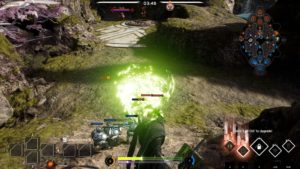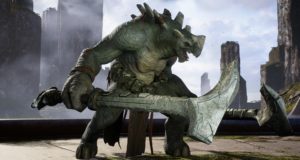Playing through my first few days with Paragon, I was constantly reminded of a quote from Dead Poets Society. “I stand upon my desk to remind myself that we must constantly look at things in a different way.” And it’s a vibe that immediately leaks from Paragon.
A third-person MOBA, its shift in viewpoint grants the entire game a different feeling, while the AAA game graphics help to distinguish it from Smite, which tends to look like World of Warcraft just as Burning Crusade released. There’s potential hidden inside Paragon that could help it become an actual game-changer from the standard MOBA. Sadly, that will most likely be hidden under a harsh items system and a bit of traditional, AAA gaming genericism.
As far as genre diversity, it’s pretty bog-standard. Three lanes, minion waves, super minion tower, nexus, diverse range of champions, etc. Where it starts to branch from the traditional MOBA is where Paragon is most interesting and shows the most potential. The third-person, over-the-shoulder camera angle feels just like standing on your classroom desk, although at times it can feel just as awkward as doing so during a lecture. Playing as a glass-cannon character such as an ADC or a mage can give you a bit of anxiety as a teamfight happens, feeling both powerful and vulnerable to the slightest explosion or pursuant running towards you.
With the perspective shift comes changes to how abilities and even basic attacks are performed. Everything from ultimate abilities to basic attacks are all “skill shots,” or abilities that have to be manually aimed or targeted. It requires players to have more skill with aiming and planning out abilities on the fly. The combat feels quicker and more intense than a traditional MOBA. Getting ganked as a squishy character has a new anxiety to it that feels like being side-tackled by a linebacker, while ganking a squishy character successfully is more reminiscent of a slug being overtaken by a car tire.
 Making character comparisons between Paragon and League of Legends is hard to avoid as a seven year veteran of the latter. The elf lady was basically Varrus, the dual-pistol guy looks like Nathan Drake and plays like Lucian. There’s a shield dude that plays like a mix of Braum and Vi. There’s an assassin character that’s pretty similar to Shaco. This isn’t to say Epic Games is directly copy-pasting characters from other MOBAs. It was more surprising to see how refreshing the perspective shift made the moves and characters feel different.
Making character comparisons between Paragon and League of Legends is hard to avoid as a seven year veteran of the latter. The elf lady was basically Varrus, the dual-pistol guy looks like Nathan Drake and plays like Lucian. There’s a shield dude that plays like a mix of Braum and Vi. There’s an assassin character that’s pretty similar to Shaco. This isn’t to say Epic Games is directly copy-pasting characters from other MOBAs. It was more surprising to see how refreshing the perspective shift made the moves and characters feel different.
Take Caitlyn from League of Legends as an example. Her ultimate ability is a long-range sniper shot that automatically tracks quickly towards the target. With the omniscient top-down view, you can run the camera around, find a target, and watch as Caitlyn takes out a chunk of health from an opponent. A Paragon hero named Murdock has a similar ultimate ability. He has a long-range shot that can travel through objects and walls that can be used to kill targets that might be trying to escape a bad teamfight. However, unlike Caitlyn, the player has to do all the work in aiming the shot. It feels like being a real sniper: aiming the shot, even needing to lead the target.
Paragon also looks gorgeous. While the combat is fun, the graphics are leaps and bounds ahead of most MOBAs on the market. With only one map there’s not too much to talk about in terms of graphical diversity other than the character models, which look more diverse than the team from Captain Planet. But Paragon does succeed in looking like a AAA title. Sometimes the textures load a bit slower than they should, and all of the jungle creatures have filler models in place of their normal model (aptly named “Alpha Content”). Hopefully these issues will be fixed when Paragon is released.

Then came the item shop. Rather than a normal item shop where any player can purchase every item in the game, players now earn card packs that have equipment cards and upgrade cards in them. Equipment cards are bought first, and then upgraded with their respective buffs. A piece of equipment, for example, that grants a player extra health and mana can only be upgraded with health and mana upgrades. These equipment and upgrade cards can be organized into a deck for a hero before a match. Only a certain number of decks can be formed, though, and each deck can only be used for one hero. There’s a limited number of deck slots, because of course there is. Playing and leveling up can earn players more deck slots, as well as more currency for buying more card packs.
This item system is going to keep away new players, since they’ll only be using the under-powered starter decks the game offers. Those that will have played longer will have a clear advantage as the game progresses, since they’ll have more refined decks. Also, for the moment, you can only buy card packs through currency earned by playing games, not using the “coins” you can buy with real-world currency. But they could easily add a coin purchase to the card packs, which could support a more “pay to win” format. The card and deck system seems like it’s trying to optimize itself for console players, but simplifies things too much, and the system offers too many points for pointless possible microtransactions. While the system isn’t currently in place, it’s definitely something to watch out for in the future.
 Overall, my first impressions are pretty positive. The perspective shift and shinier graphics could help attract people that are a bit more skeptic when it comes to traditional MOBAs. However, there really is a lack of content right now. League of Legends started its launch with a full 40 champions, as well as an item system that was less complex and harmful to new players. Currently, there’s only fifteen heroes in Paragon. Epic has promised there will be one new hero every three weeks, but its known just how long that promise will last.
Overall, my first impressions are pretty positive. The perspective shift and shinier graphics could help attract people that are a bit more skeptic when it comes to traditional MOBAs. However, there really is a lack of content right now. League of Legends started its launch with a full 40 champions, as well as an item system that was less complex and harmful to new players. Currently, there’s only fifteen heroes in Paragon. Epic has promised there will be one new hero every three weeks, but its known just how long that promise will last.
The definition of paragon is “a person or thing regarded as a perfect example of a particular quality.” In its current state, even putting aside things like missing jungle creeps, it’s definitely not perfect. Paragon changes a lot of the traditional MOBA formula around, some for good and some for ill. But there’s definitely a good foundation for a solid MOBA in Paragon. Hopefully fleshing out the universe or adding a few more heroes soon can increase its popularity and help it not become another Infinite Crisis or Guardians of Middle Earth.
Paragon was played during its closed beta on the PS4.

